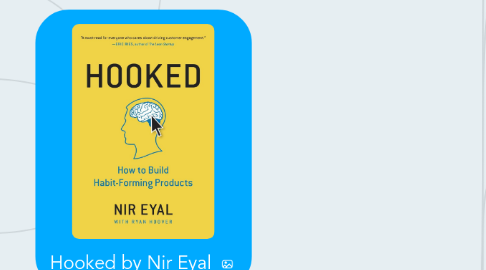
1. Chapter 4
2. Chapter 5
3. Chapter 6
4. Introduction
4.1. Samples
4.1.1. 79% of smartphone owners checked their device within 15 min of waking up
4.1.2. 33% of americans will give up sex than lose their c/ps
4.2. benefits to companies of habit forming
4.2.1. More clients
4.3. 4 Steps/Phases of the Hook Model
4.3.1. Triggers Phase
4.3.1.1. Internal
4.3.1.2. External
4.3.2. Action Phase
4.3.2.1. ease of performing the action
4.3.2.2. and motivation to do it
4.3.3. Variable Reward Phase
4.3.3.1. to create craving
4.3.3.2. increasing variability of the reward increases the dopamine
4.3.4. Investment Phase
4.3.4.1. when users put in some of their time/resources into the product
4.3.4.2. inviting friends, collecting items, pin, re-pin, re-tweet, re-post etc.
4.4. Take Away/ Do this Now Session
4.4.1. Habits are defined as behaviors done with little or no conscious thought
4.4.2. Convergence of access to data and speed is making the world a habit forming place
4.4.3. business that create customer habit gain a significant competitive advantage
4.4.4. Hook model is designed to connect the users problem with a solution that forms a habit
4.5. Note: similar to book " Contagious" by Jonah Berger
4.5.1. STEPPS
4.5.1.1. Social Currency
4.5.1.2. Triggers
4.5.1.3. Emotion
4.5.1.4. Public
4.5.1.5. Practical Value
4.5.1.6. Stories
5. Chapter 1: The habit zone
5.1. Habits are one of the ways the brain learns complex behaviors
5.2. changes your behavior and creates unprompted user engagement
5.2.1. not for infrequently bought products
5.3. Benefits of habit forming products for Companies
5.3.1. increases customer lifetime value
5.3.2. providing pricing flexibility.
5.3.2.1. More habit formed products, the more flexibility in pricing
5.3.2.2. gaming earns from freemium models once users are hooked. aka. Candy Crush and evernote
5.3.2.2.1. Smile Graph
5.3.2.2.2. as usage increases over time, so do customers willingness to pay from 5% to 11% to 26% (month 32)
5.3.3. supercharge growth
5.3.3.1. hooked users become brand evangelist
5.3.3.2. ex: Facebook vs Myspace
5.3.3.2.1. More is More= viral cycle time
5.3.4. sharpening the competitive edge
5.3.4.1. you need to be 9x better to be able to overcome habit. (old habits die hard)
5.3.4.1.1. must be dramatically better to shake users out of their old routine.
5.3.4.2. QWERTY vs DVORAK keyboards
5.4. How to Plot habit forming potential? Plot these two values
5.4.1. Frequency
5.4.1.1. the higher the better
5.4.2. Perceived Utility
5.4.2.1. the higher, the better
5.4.2.2. vitamin or pain killer?
5.5. Building the Mind Monopoly
5.5.1. successfully changing users habit is rare
5.5.2. Habit designs and caveats
5.5.2.1. New behaviors have a short half life
5.5.2.1.1. Last in, First out
5.5.2.1.2. 75% of alcoholics will return to drinking over time
5.5.2.1.3. weight loses will gain it back in 2 years
5.5.2.2. Old habits die hard
5.5.2.2.1. Google example
5.5.3. habits as a strategy
5.5.3.1. user must get a high degree of utility
5.5.3.1.1. amazon example
5.5.4. Progressing users through the 4 hook models
5.5.4.1. remember and share
5.5.4.2. forming strong user habits have business benefits
5.5.4.3. habits can not form outside the habit zone (frequency and utility)
5.5.4.4. habits start as nice to have vitamins, but once it becomes a habit...it becomes a must have pain killer
5.5.4.5. habit forming products alleviates a users pain by relieving a pronounced itch
5.5.4.6. it is a form of manipulation. Introspection needed
5.6. Do this now
5.6.1. what habits does your business model require
5.6.2. what problem are users turning to your product to solve?
5.6.3. how are they solving it now? Do they need a new solution?
5.6.4. How frequently do users engage with your product?
5.6.5. what user behavior do you want to make into a habit
6. Chapter 2:trigger
6.1. Owned Triggers
6.2. 4 steps of the Hook Model.
6.2.1. Triggers
6.2.1.1. Internal Triggers
6.2.1.2. External Triggers
